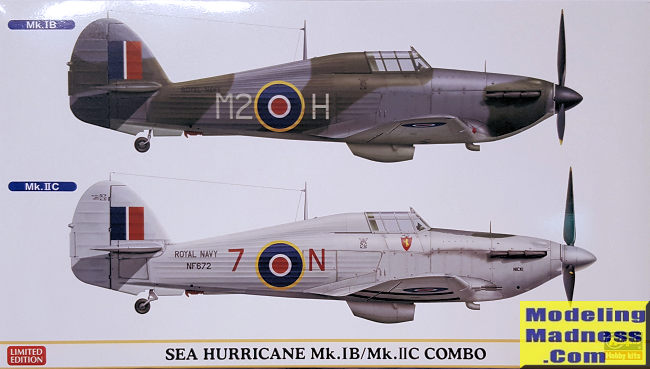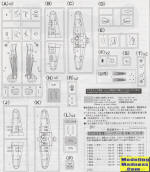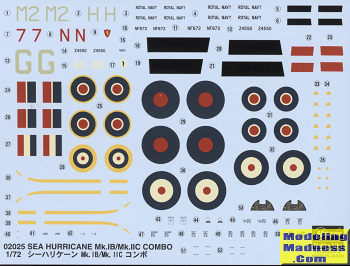
Hasegawa 1/72 Sea Hurricane Combo
| KIT #: | 02025 |
| PRICE: | 3500 yen when new |
| DECALS: | Three options |
| REVIEWER: | Scott Van Aken |
| NOTES: | 2013 Limited Edition with resin parts |

| HISTORY |
The Hurricane originated from discussions between RAF officials and aircraft designer Sir Sydney Camm about a proposed monoplane derivative of the Hawker Fury biplane in the early 1930s. Despite an institutional preference for biplanes and lack of interest from the Air Ministry, Hawker refined their monoplane proposal, incorporating several innovations which became critical to wartime fighter aircraft, including retractable landing gear and the more powerful Rolls-Royce Merlin engine. The Air Ministry ordered Hawker's Interceptor Monoplane in late 1934, and the prototype Hurricane K5083 performed its maiden flight on 6 November 1935.
In June 1936, the Hurricane went into production for the Air Ministry; it entered squadron service on 25 December 1937. Its manufacture and maintenance was eased by using conventional construction methods so that squadrons could perform many major repairs without external support. The Hurricane was rapidly procured prior to the outbreak of the Second World War in September 1939, when the RAF had 18 Hurricane-equipped squadrons in service. The aircraft was relied on to defend against German aircraft operated by the Luftwaffe, including dogfighting with Messerschmitt Bf 109s in multiple theatres of action.
The Hurricane was developed through several versions, into bomber-interceptors, fighter-bombers, and ground support aircraft as well as fighters. Versions designed for the Royal Navy known as the Sea Hurricane had modifications enabling operation from ships. Some were converted as catapult-launched convoy escorts.
The Sea Hurricane was never more than a stop-gap until something more potent and nautical-friendly came along. It basically provided a potent single seat fighter when the Fleet Air Arm did not have one. It was modified with an a-frame arresting gear and catapult launching attachment. It did not have folding wings, which reduced the number that could be carried. The British never really did develop a decent nautical fighter during WWII and while the Seafire helped, it was a weak design and a fairly large number were lost to accidents. It wasn't until the Wildcat, Hellcat, and Corsair entered service that the British finally had a decent naval fighter.
| THE KIT |
 This
kit combines two of their major boxings with a resin section to produce the
combo kit. One is the standard all gun wing kit and the other is the dual
cannon wing kit. The rest of the sprues are identical. One of the bags contains
the two resin tailhook sections. You do have to remove the lower aft fuselage
section to install the resin replacements and one of these also gets a different
tail gear to what is molded in place. The instructions show you just what has to
be trimmed or added.
This
kit combines two of their major boxings with a resin section to produce the
combo kit. One is the standard all gun wing kit and the other is the dual
cannon wing kit. The rest of the sprues are identical. One of the bags contains
the two resin tailhook sections. You do have to remove the lower aft fuselage
section to install the resin replacements and one of these also gets a different
tail gear to what is molded in place. The instructions show you just what has to
be trimmed or added.
Cockpits of both aircraft are very basic with just a floor, seat, control stick and instrument panel. Noses are separaate on these kits as they are slightly different depending on which version you are building. Gear wells are molded into the lower fuselage and the landing gear are fairly nicely done. You are given a single transparency for each plane as there really isn't much to see in the cockpit. Both aircraft use the deHavilland prop so put the Rotols in the spares box. You also have different spinner lengths. In addition, you have to add the resin catapult bits on either side of the ventral radiator.
 There are
three markings options. You have two options for the earlier Sea Hurricane Mk.IB,
both in the standard dark sea grey/dark slate grey over sky. Instructions show
you having to mix the slate grey. The other is the Mk.IIC with the canon in an
overall white scheme except for a small area just in front of the windscreen.
Now, if you are willing to do a bit of additional work to the cannon wing, you
could probably do both Mk.IB aircraft if you are willing to overlook the
slightly longer engine cowling and later tail gear supplied with the IIC kit.
Decals are very nicely done and should provide no issues.
There are
three markings options. You have two options for the earlier Sea Hurricane Mk.IB,
both in the standard dark sea grey/dark slate grey over sky. Instructions show
you having to mix the slate grey. The other is the Mk.IIC with the canon in an
overall white scheme except for a small area just in front of the windscreen.
Now, if you are willing to do a bit of additional work to the cannon wing, you
could probably do both Mk.IB aircraft if you are willing to overlook the
slightly longer engine cowling and later tail gear supplied with the IIC kit.
Decals are very nicely done and should provide no issues.
| CONCLUSIONS |
Several of you are probably aware that Revell used to do a Sea Hurricane kit and it was a fairly nice model. Hasegawa has had to resort to resin inserts to do their Sea Hurricane and while I can't say which kit is better, this one will certainly fill the requirement with a very nice model when done.
| REFERENCES |
https://en.wikipedia.org/wiki/Hawker_Hurricane
September 2020 Copyright ModelingMadness.com. All rights reserved Review kit courtesy of my wallet. If you would like your product reviewed fairly and fairly quickly, please contact the editor
or see other details in the
Note to
Contributors. Back to the Main Page
Back to the Review
Index Page
Back to the Previews Index Page